Wild seaweed harvesting: strategic environmental assessment - environmental report
Investigates the sustainability and potential environmental impacts of wild seaweed and seagrass harvesting, maerl extraction and removal of beach-cast seaweed.
4. Biodiversity
4.1. Physical conditions
Wave Exposure and Sediment Types
4.1.1. Physical conditions vary widely around Scotland's coastline and inshore waters. The western coast of the Western Isles is very exposed to wave action ( Figure 13) from the Atlantic Ocean and is therefore predominantly characterised by rock ( Figure 14 and Figure 15), with some sandy bays in more sheltered areas (Baxter et al., 2011). Sheltered fjordic sea lochs are common along the west coast of the Scottish mainland, while fjardic [13] sea lochs with complex basins, lagoons and tidal rapids are characteristic of many locations on the eastern coasts of the Western Isles. The main sediment types between the Scottish mainland and the Western Isles are coarse sands, gravels and rock. Sandy bays are widespread while very sheltered areas are characterised by muddy sediment (Baxter et al., 2011).
4.1.2. Similar conditions are experienced along the northern coast of the Scottish mainland, western Shetland, Fair Isle and Orkney, which are all exposed to the full force of the Atlantic. These areas are thus also characterised by rocky habitats with sheltered areas supporting intertidal sands. Fine sediments are restricted to very sheltered areas such as Scapa Flow in Orkney (Baxter et al., 2011).
4.1.3. The northern section of the east coast is characterised by small inshore firths, often with sandbanks, mudflats and sandy beaches. The rest of the east coast lacks the complexity of the west coast but includes major firths, sea cliffs and stretches of rocky coastline interspersed with long sandy beaches. Extensive mud and sand flats systems are present in the Forth and Tay estuaries (Baxter et al., 2011).
Figure 13: Wave Exposure Index [14]
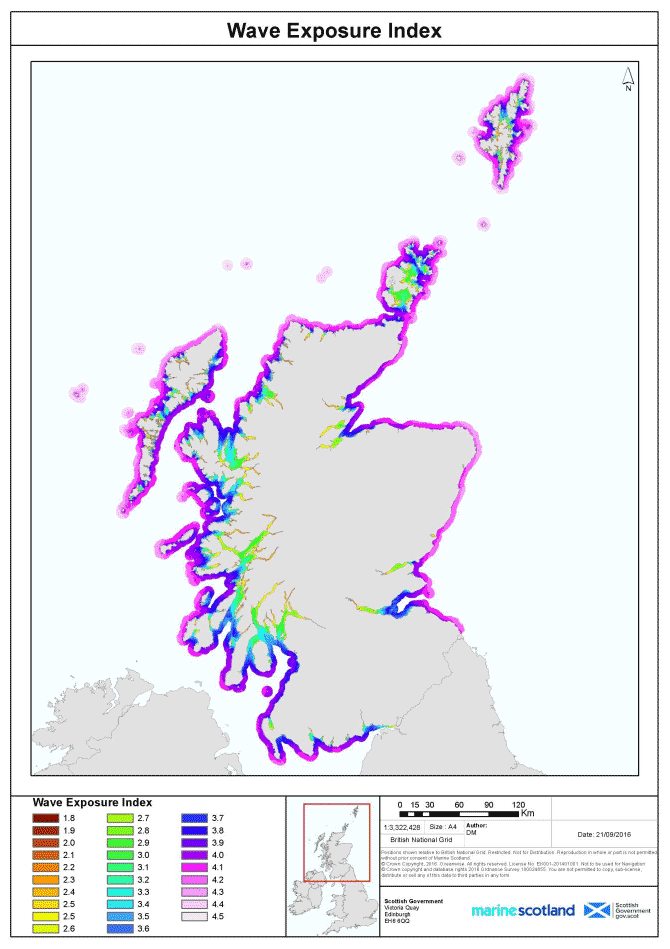
Figure 14: Modelled distribution of broad habitats in Scotland's marine environment [15]
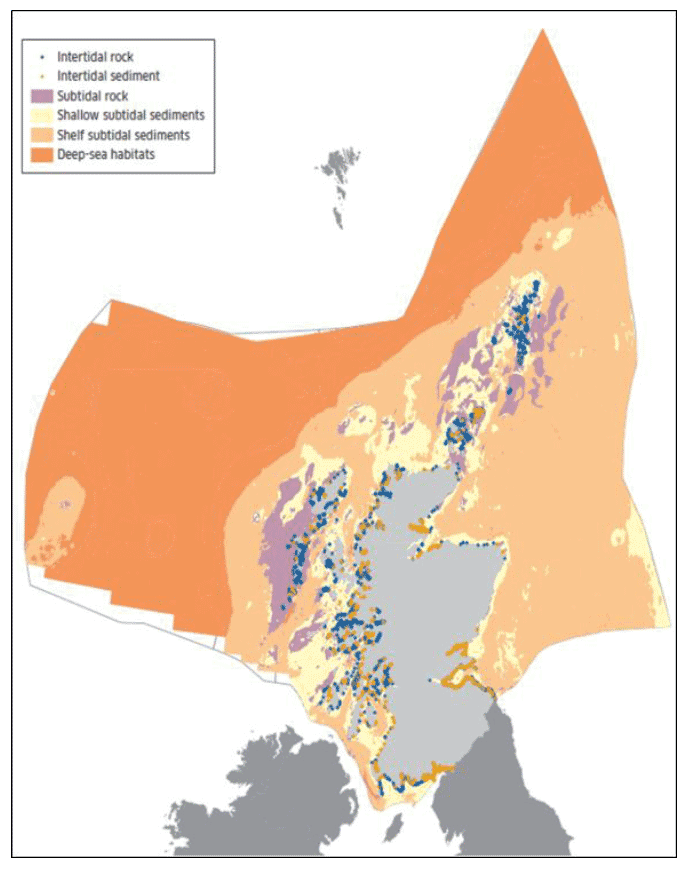
Figure 15: Seabed Sediments in Scottish Coastal and Inshore Waters

4.2. Ecological Status
4.2.1. The current overall status of Scottish coastal and transitional water bodies is shown in Figure 16. Overall, the majority of coastal and transitional water bodies have "good" or "high" status (and "good ecological potential"). A few are classified as "moderate" or "poor" ( Table 8).
Table 8. Moderate/Poor Ecological Status/Potential in Scottish Coastal Waters
| Location |
Element(s) |
Detail |
|---|---|---|
| Outer Tay Estuary |
chemical quality |
dissolved inorganic nitrogen |
| Loch Linnhe |
biological quality |
benthic invertebrates |
| Firth of Clyde |
biological quality hydromorphological quality chemical quality |
benthic invertebrates physical condition, barriers and morphology oxygen levels and dissolved oxygen |
| Solway Firth |
biological quality chemical quality |
phytoplankton and fish dissolved inorganic nitrogen, nutrient levels |
| Firth of Forth |
hydromorphological quality |
physical condition, barriers and morphology |
4.2.2. The status of the macroalgal indicators ( Figure 16) is good or high, apart from the Montrose Basin (moderate due to macroalgal blooming). This in turn may affect seagrass through smothering and reduced light levels. The status of the marine angiosperms indicator has not been reported for coastal and transitional Water Framework Directive ( WFD) water-bodies.
Figure 16: Water body status: overall and macroalgae in Scotland

4.3. Seaweeds and Seagrasses as WFD Biological Quality Elements
4.3.1. The WFD establishes a framework for the management and protection of Europe's water resources, transposed. This became law in Scotland as through the Water Environment and Water Services (Scotland) Act 2003 ( WEWS Act). It is implemented in Scotland through The Water Environment (Controlled Activities) (Scotland) Regulations 2011 (more commonly known as CAR) which provide the regulatory controls over activities which may affect Scotland's water environment.
4.3.2. The WFD aims to achieve 'good ecological and good chemical status' in all inland and coastal waters by 2021 (or 2027), apart from in heavily modified in water bodies, where it may be impossible to get to a near natural condition because they have been substantially modified for reasons such as flood protection or to allow navigation. The aim in such waters is to achieve an alternative objective of 'good ecological potential'.
4.3.3. The WFD considers the ecological status of indicator species to reflect the quality, structure and functioning of aquatic ecosystems (Wallenstein et al., 2013). These biological indicators include primary producers and benthic fauna, e.g. benthic invertebrates, phytoplankton and macroalgae. Both seaweeds and seagrasses are WFD indicators because they are important contributors to many coastal ecosystems including rocky shores, soft bottom intertidal and subtidal zones, reefs and saltmarshes (Orfanidis et al., 2001). These species are sessile and respond directly to abiotic and biotic pressures. For example, if eutrophication occurs, perennial seaweeds such as Fucus spp. may be replaced by opportunistic seaweeds like Ulva spp. (Orfanidis et al., 2001 and references therein).
4.3.4. The ecological quality of water bodies is assessed by comparing the status of biological indicators against the reference conditions expected of a pristine water body (Wilkinson et al., 2007). For macroalgae, assessment considers composition, macroalgal cover and abundance ( WFD- UKTAG, 2014). There are, however, uncertainties associated with using macroalgae as ecological indicators. For example, it is not always known which species are sensitive to which pressures (natural or anthropogenic) and also species composition can vary naturally regardless of anthropogenic pressures (Wilkinson and Wood, 2003). As such, different methods have evolved in different countries as to the best way to use seaweeds as an ecological indicator ( e.g. Orfanidis et al., 2001; Wells et al., 2007a; Juanes et al., 2008). In the UK, species richness has been found to provide a consistent response to anthropogenic impacts that does not appear to be significantly affected by natural variation (Wells et al., 2007b) and can therefore be used, along with other measures, to assess variations in the ecological quality of a water body.
4.4.1. Seaweeds and seagrasses play a key role in marine and coastal ecosystems. Their importance in ecological functioning is recognised by the fact that they are used as indicators for assessing the ecological status of WFD water bodies (see Section 4.4). They are included as features within a number of designated sites (Marine Scotland, 2015). Five Nature Conservation Marine Protected Areas ( MPA) directly support protected features that include seaweed (Marine Scotland, 2015) ( Table 9 and Figure 17). Seaweeds and seagrasses are also included in the list of Scottish Priority Marine Features ( PMFs) ( Table 10). Some Special Areas of Conservation ( SAC) contain Annex 1 habitat interest features that potentially support seaweeds and seagrasses ( Table 11 and Figure 17).
4.4.2. In addition, 15 sites in Scotland have been nominated as Important Plant Areas [16] ( IPAs) for marine seaweeds (Brodie et al., 2007). IPAs that are not already designated as a SAC or MPA include Isle of Cumbrae, Tiree (Argyll), Sound of Islay (Inner Hebrides), Sound of Harris (Outer Hebrides), Loch Eriboll (Sutherland), St. Andrews (Fife) and Pettico Wick (Scottish Borders).
4.4.3. SNH has advised that, for Sites of Special Scientific Interest ( SSSIs), marine notified habitats include eelgrass beds, mudflats, rocky shore, saline lagoon, sandflats and sea caves (in addition to those with relevant bird features shown on Figure 20. Species features include brackish water cockle ( Cerastoderma glaucum), egg wrack ( Ascophyllum nodosum f. mackayi), grey seal, foxtail stonewort ( Lamprothamnium papulosum) and vascular plant assemblage (which cover eelgrass communities in some sites).
Table 9. Nature Conservation MPAs directly supporting seaweed features
| MPA |
Protected Seaweed Feature |
|---|---|
| Fetlar to Haroldswick |
kelp and seaweed communities on sublittoral sediment; maerl beds |
| Loch Sween |
maerl beds |
| South Arran |
kelp and seaweed communities on sublittoral sediments; maerl beds; maerl or coarse shell gravel with burrowing sea cucumbers |
| Wester Ross |
kelp and seaweed communities on sublittoral sediment; maerl beds; maerl or coarse shell gravel with burrowing sea cucumbers |
| Wyre and Rousay Sounds |
kelp and seaweed communities on sublittoral sediment; maerl beds |
Figure 17: SACs/ SCIs [17] and MPAs with seaweed or seagrass interest features
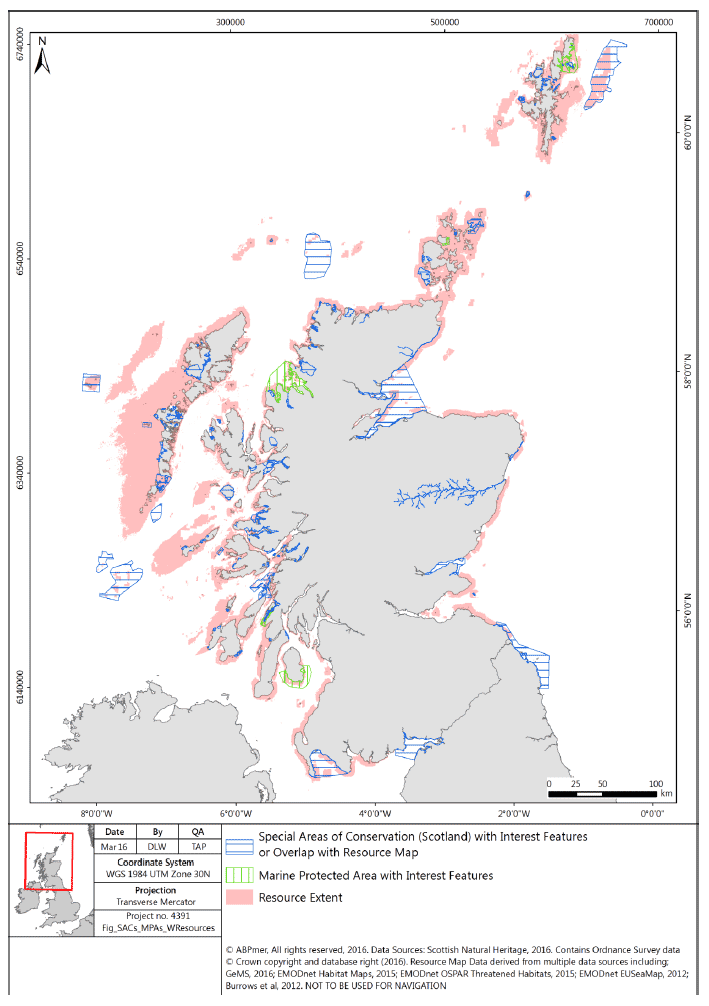
Table 10: Priority marine features: seaweeds and seagrasses [18]
| Priority marine feature |
Component biotopes / species (biotope / common name) |
|---|---|
| Horse mussel beds |
Modiolus modiolus beds with hydroids and red seaweeds on tide-swept circalittoral mixed substrata |
| Kelp and seaweed communities on sublittoral sediment |
Kelp and seaweed communities on sublittoral sediment |
| Kelp beds |
Laminaria hyperborea forest with a faunal cushion (sponges and polyclinids) and foliose red seaweeds on very exposed upper infralittoral rock |
| Laminaria hyperborea with dense foliose red seaweeds on exposed infralittoral rock |
|
| Laminaria hyperborea on tide-swept, infralittoral rock |
|
| Laminaria hyperborea on tide-swept infralittoral mixed substrata [19] |
|
| Laminaria hyperborea and foliose red seaweeds on moderately exposed infralittoral rock |
|
| Low or variable salinity habitats |
Kelp in variable or reduced salinity |
| Submerged fucoids, green or red seaweeds (low salinity infralittoral rock) |
|
| Bird's nest stonewort Tolypella nidifica |
|
| Baltic stonewort Chara baltica |
|
| Foxtail stonewort Lamprothamnium papulosum |
|
| Maerl beds |
Maerl beds |
| Maerl or coarse shell gravel with burrowing sea cucumbers |
Neopentadactyla mixta in circalittoral shell gravel or coarse sand |
| Sea loch egg wrack beds |
Ascophyllum nodosum ecad mackaii beds on extremely sheltered mid eulittoral mixed substrata |
| Tide-swept algal communities
|
Fucoids in tide-swept conditions |
| Halidrys siliquosa and mixed kelps on tide-swept infralittoral rock with coarse sediment |
|
| Kelp and seaweed communities in tide-swept sheltered conditions |
|
| Laminaria hyperborea on tide-swept infralittoral mixed substrata [20] |
|
| Seagrass beds
|
Zostera noltii beds in littoral muddy sand |
| Zostera marina/angustifolia beds on lower shore or infralittoral clean or muddy sand |
|
| Ruppia maritima in reduced salinity infralittoral muddy sand |
Table 11: Annex 1 marine habitats supporting seaweeds and seagrasses
(Source: JNCC website http://jncc.defra.gov.uk/page-4166)
| Annex 1 Marine Habitats |
Special Area of Conservation |
|---|---|
| Coastal lagoons (except where landwards of MHWS and not directly connected to the sea) sites where this is a qualifying feature but not a primary reason for site selection: |
|
| Estuaries (Where rock occurs, there may be characteristic communities consisting of green algae, sparse fucoid seaweeds) |
|
| Large shallow inlets and bays |
|
| Reefs Sites where this is a qualifying feature but not a primary reason for site selection: |
|
| Sandbanks which are slightly covered by seawater all the time: sites supporting maerl and/or seagrasses |
|
| Submerged or partially submerged sea caves (Caves may support shade-tolerant seaweeds near their entrances) [21] |
|
4.5.1. Marine mammals in Scotland's coastal and marine waters include cetaceans, seals and otters.
Cetaceans
4.5.2. Over 25 species of cetacean have been recorded off the coast of Scotland. However, only seven species are considered resident or regular seasonal visitors (harbour porpoise Phocoena phocoena, Risso's dolphin Grampus griseus, shortbeaked common dolphin Delphinus delphis, bottlenose dolphin Tursiops truncates, orca Orcinus orca, minke whale Balaenoptera acutorostrata and white-beaked dolphins Lagenorhynchus albirostris). Cetaceans regularly recorded offshore from north west Scotland (particularly along the shelf edge in deeper waters) include Atlantic white-sided dolphins Lagenorhynchus acutus, long-finned pilot whales Globicephala melas, fin whales Balaenoptera physalus, sperm whales Physeter macrocephalus and beaked whales (Reid et al., 2003; Clark et al., 2010; Baines and Evans, 2012; CODA, 2009).
4.5.3. There is one Special Area of Conservation for bottlenose dolphin, in the Moray Firth, and one Special Area of Conservation for harbour porpoise in the Inner Hebrides and the Minches ( Figure 18).
Figure 18: SAC for harbour porpoise
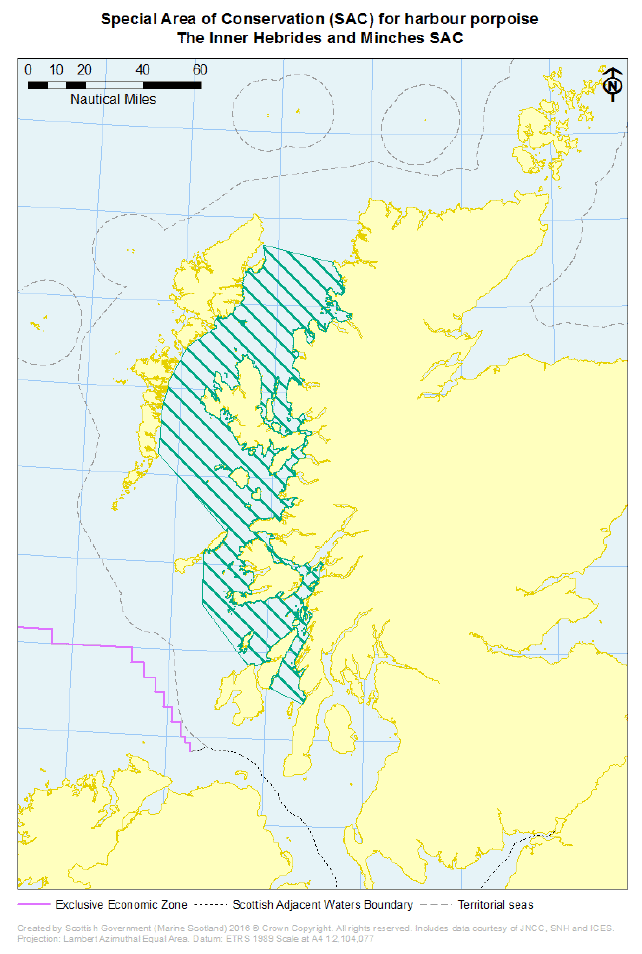
Seals
4.5.4. Two species of seal are present in Scottish waters, grey seal Halichoerus grypus and the common seal Phoca vitulina. The coast of Scotland hosts important breeding and foraging grounds for both of these species ( SCOS, 2013). There are eight SACs designated for harbour seal, and five for grey seal ( Appendix D, Table D6 ). SNH recommend using species-specific foraging distances in order to establish the potential for connectivity between seal SAC populations and seaweed or seagrass beds.
4.5.5. Seal haul-out sites are locations on land where seals come ashore to rest, moult or breed. The Scottish Government has designated 194 specific seal haul-out sites to provide additional protection for seals from intentional or reckless harassment ( Figure 19), and recently consulted on a proposal to designate an additional site in the Ythan Estuary.
4.5.6. Grey seal SACs are principally breeding sites. Grey seals congregate for pupping and mating and then disperse. Grey seals are at the breeding sites for a relatively short period of the year, do not tend to make long foraging trips while there and then disperse very widely and do not necessarily have any focus on that SAC site for the rest of the year. There is growing evidence that some grey seals can disperse widely, spending a considerable amount of the rest of the year well away from their breeding sites. SNH therefore recommend that a foraging distance of 20 km from SACs is appropriate when considering connectivity during the breeding season for grey seals.
4.5.7. Harbour seals are relatively loyal to a SAC site and often remain local to a relatively discrete area, including outside the breeding season, so connectivity with the SAC is stronger for this species all year round than is indicated for grey seals. SNH therefore recommends a foraging distance of 50 km from SACs is appropriate when considering connectivity for harbour seals. This distance applies all year.
Figure 19: Location of designated seal haul-out sites.

Otters
4.5.8. Otters ( Lutra lutra) are found in coastal areas in Scotland, as well as inland fresh waters. On the coast they tend to utilise shallow, inshore marine areas for feeding ( JNCC, 2016) . The foraging range of otters is considered to be 4 to 5 km ( SNH, 2015a). Most otters forage within a 10 m depth.
4.5.9. There are twelve SACs in Scotland designated for otters, and another 32 where otters are a qualifying feature but not the primary reason for site selection. Of these, six have been identified as being sensitive to seaweed harvesting activities ( Appendix D, Table D6 )
4.6. Seabirds
4.6.1. A wide variety of seabirds is found around the coast of Scotland. St Kilda, the Shiant Isles, Handa, North Rona and Sula Sgeir, Rum, Mingulay and Berneray and Sule Skerry and Sule Stack are all breeding colonies that support in excess of 100,000 breeding seabirds each year. Other important breeding colonies regularly supporting over 20,000 species include East Caithness Cliffs, Inner Moray Firth, Firth of Tay and Eden Estuary, and Firth of Forth ( DECC, 2004). The species breeding in these colonies include, but are not limited to, Leach's Storm Petrel, Shag, Gannet, Great Skua, Puffin, Razorbill, Fulmar, Manx Shearwater, Kittiwake, and Guillemot. The largest breeding colony in Scotland is at St Kilda, located approximately 65 km off the west coast of the Outer Hebrides, where approximately 600,000 seabirds breed on an annual basis (Stroud et al., 2001).
4.6.2. SNH has advised on bird species that are features of designated and proposed nature conservation sites and use coastal waters that could potentially overlap with living seaweed resources. Sites supporting these species (which comprise SPAs, draft SPAs ( dSPAs) [22] , Nature Conservation MPAs and Sites of Special Scientific Interest ( SSSIs)) are included in Figure 20. A list of these sites and associated bird features are included in Appendix D Tables D1 to D4 .
4.6.3. Some designated sites also support shorebirds that are dependent on living and/or beach cast seaweeds and seagrasses. Sites that have wintering or breeding wader species that are known to either use cast seaweed on the shoreline and/or feed on organisms living in seaweed beds in the intertidal zone as previously advised by SNH are included in Appendix D (Table D5) and shown on Figure 20.
4.6.4. Black Guillemots have been associated with kelp forests. Although there is no evidence that other seabirds, such as Common Guillemots or Razorbills, forage in kelp forests, there is potential for indirect effects due to impacts on prey populations.
Figure 20: Designated and proposed sites supporting bird features that use coastal waters and could potentially overlap with living seaweed and birds that are dependent on beach-cast seaweed and/or intertidal seaweed beds
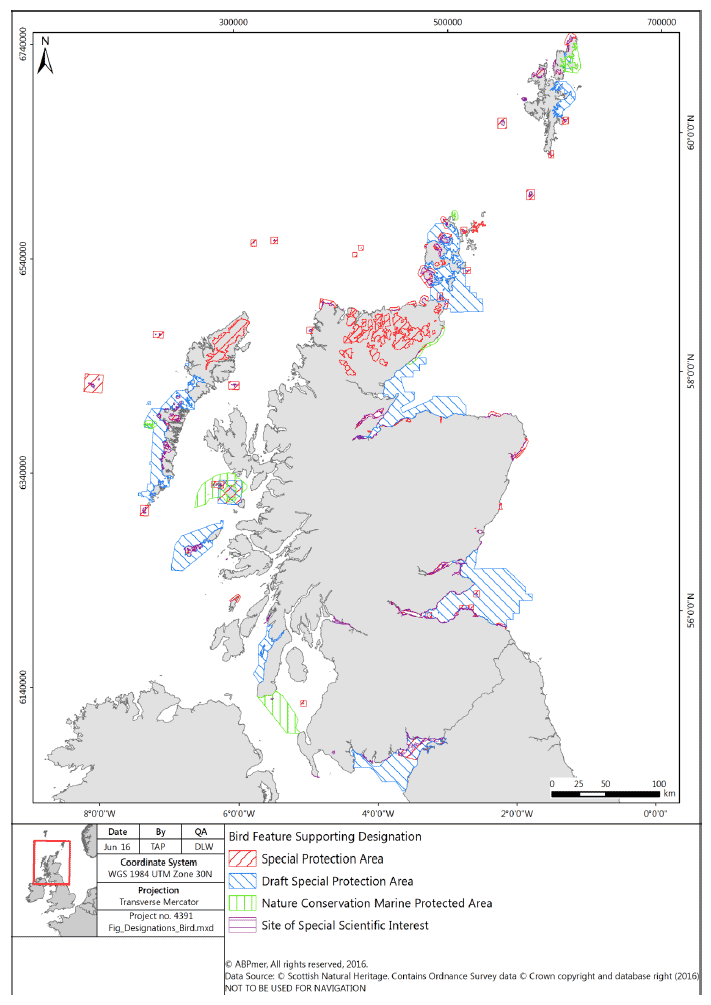
4.7.1. A large number of fish species inhabit Scottish waters. Some of these are of conservation importance. Atlantic salmon, sea, brook and river lamprey, and shad are species protected by Special Areas of Conservation. Other species, such as eel, skate, and commercial species of fish, are Priority Marine Features. These commercial species include (but are not limited to) cod, ling, horse mackerel and sandeel.
4.7.2. Scottish waters are used as a nursery ground by several species, including spurdog, tope Galeorhinus galeus, skate, thornback ray Raja clavata, spotted ray Raja maculata, herring Clupea harengus, cod Gadus morhua, whiting, blue whiting Micromesistius poutassou, ling Molva molva, hake Merluccius merluccius, angler fish Lophius piscatorius, sandeel Ammodytes spp., mackerel Scomber scombrus and plaice Pleuronectes platessa. Two species (sandeel and mackerel) are also thought to spawn at several locations in Scottish waters (Ellis et al., 2012).
4.7.3. The main commercial species landed from within the ICES region VIa (the region encompassing the west coast of Scotland) are mackerel, blue whiting, herring, horse mackerel, hake, saithe, haddock, ling, nephrops, crab and scallops. Across the east coast, in areas classed as the northern and central North Sea ( ICES region IVb), fisheries tend to focus on cod, haddock, whiting, monkfish, nephrops, herring and mackerel ( DECC, 2004). Cod, haddock and whiting are also important fisheries off the north coast of Scotland ( ICES region IVa), along with saithe, Greenland halibut, Nephrops, scallops, herring, mackerel, sandeel, blue whiting and Norway pout (Gordon, 2003).
4.7.4. A diverse range of shellfish species can also be found off the coast of Scotland. Species include nephrops Nephrops norvegicus, European lobster Homarus gammarus, brown crab Cancer pagurus, velvet swimming crab Necora puber and scallops Pecten maximus. Shellfish distribution is highly dependent on sediment type, and therefore distribution tends to be patchy and discrete due to the complex distribution of habitats and sediment types (Marine Scotland, 2013).
4.7.5. Adult European lobsters are reported to show a preference for rocky crevice habitat with gravel and cobble as nursery habitat (Seitz et al., 2014) though it is noted that there is little information on juvenile phases. There is some information to suggest that juvenile lobsters may prefer coarse substrate with suitable crevices, or burrow in mud (Howard and Bennet, 1979). There is evidence that some crab species actively settle in mussel beds, rocky shores, seagrass beds Zostera marina and macroalgae (Moksnes, 2002) and that nursery habitats may vary depending on local abiotic and biotic factors (Heraghty, 2013).
4.8. Nursery and Spawning Grounds
4.8.1. Seaweeds and seagrasses provide a niche habitat during various life stages to a number of species. These include migratory and reproductive areas for fish and invertebrates, including nursery and spawning grounds. The distribution of nursery and spawning grounds in Scottish waters for key demersal and pelagic fish species in relation to the known and potential distribution of seaweed and seagrass habitat is shown in Figure 21. These maps show broad indicative areas for potential spawning and nursery grounds only. The use or importance of such grounds is not necessarily spatially consistent and may vary between and within years.
4.8.2. The data used to inform the spawning and nursery areas in Figure 21 are based on survey work that does not overlap with areas of kelp bed distribution. However, fish sensitivity maps are available that serve as an update of the existing fish nursery maps ( Figure 22). These fish sensitivity layers have been generated to identify the probability of the presence of high abundances of 0-group fish (fish in the first year of their life) in Scottish waters as a broad indicator of the distribution of nursery areas. The main limitation of these maps is that there are information gaps for the inshore areas on the west coast of Scotland. Therefore, whilst they give a more considered distribution of 0-group fish, they can only do so where the data is available.
4.8.3. Seagrass rhizomes provide a more stable habitat that can be used as a nursery area by a number of species (Wilkinson & Wood, 2003). It is well documented that the provision of suitable nursery and spawning grounds by seaweed and seagrass habitats is of great importance to many species, including species of commercial and recreational value (Jackson et al., 2008; Unsworth and Cullen-Unsworth, 2015). For example, juvenile cod shelter in kelp forests and seagrass beds (Seitz et al., 2013) and cuttlefish ( Sepia officinalis) are known to attach eggs directly onto the blades of Zostera marina (Blanc & Daguzan, 1998 in Jackson et al., 2001). Herring ( Clupea harengus) in the North East Atlantic and North Sea appear to spawn on vegetation (Haegele and Schweigart, 1985). Recognised spawning grounds on the west coast of Scotland are shown in Figure 23. Juanes (2007) found that the mortality risk of cod is lower in more complex habitat structures provided by kelp forests and seagrass beds than in simple ones. It appears that the complexity of the habitat become less important to individual survival in older life stages (Seitz et al., 2013). Maerl beds can also act as reproductive reservoirs for future generations of commercially important species, e.g. cod, edible crabs and scallops (Lancaster et al., 2014a).
Figure 21: Nursery and spawning grounds for key fish species
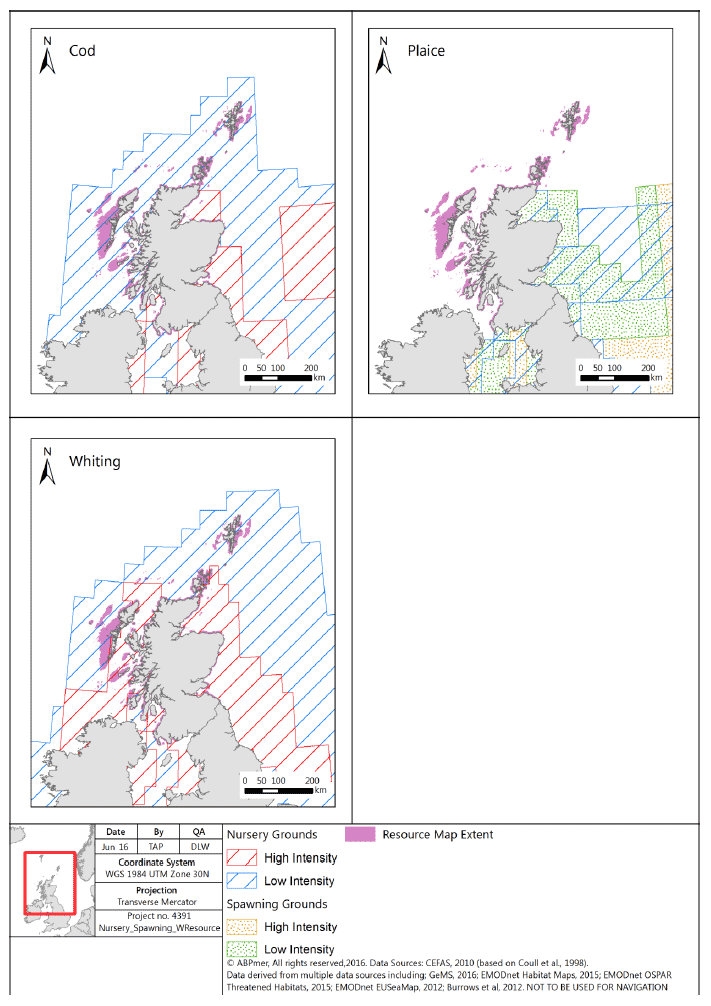
Figure 22: Fish sensitivity maps for 0-group fish species
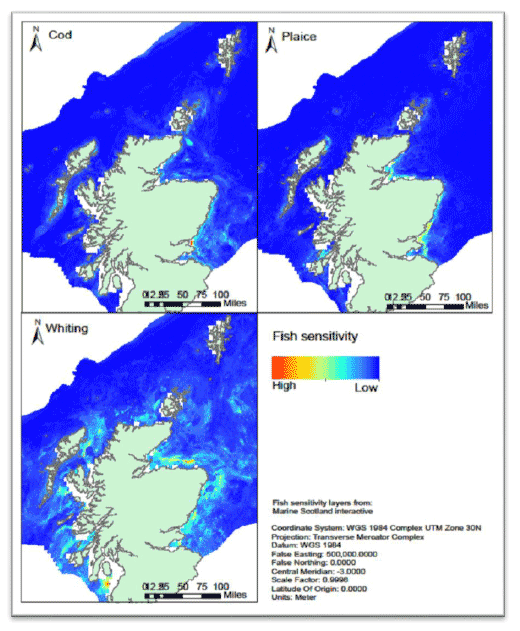
4.8.4. Drifting seaweed provides juvenile fish with shelter from predators such as larger fish and birds (Orr, 2013). Beaches on the west coast of Scotland are used as nursery grounds by a number of commercially important benthic fish species, such as European plaice Pleuronectes platessa and dab Limanda limanda (Gibson et al., 1993 cited in Orr, 2013). The abundance of juvenile fish in the surf-zone in western Australian beaches was positively related to the volume of drifting macroalgae (Orr, 2013 and references therein). Therefore, the greater abundances of prey and enhanced habitat complexity provided by drifting macroalgae may increase the survival of juvenile fish in nursery areas in Scotland (Orr, 2013).
Figure 23: ICES management areas and the known spawning grounds for herring are shown in red (Source: Geffen et al., 2011).
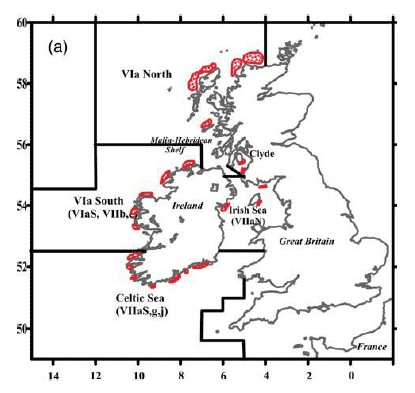
Contact
There is a problem
Thanks for your feedback